Girls who are boys who like boys to be girls
Who do boys like they're girls, who do girls like they're boys
Always should be someone you really love |
| Girls and Boys – Blur |
Middle-class author Lettice Mason (Joan Greenwood) – and yes, that's her name, and every time it's spoken it does sound like 'lettuce' – is arranging a small dinner party to welcome her son Laurie (Clive Francis) home after a six-month spell in a psychiatric hospital. Her husband, secondary modern school headmaster George (Michael Hordern), is considerably less keen on such a gathering, having just arrived home from a typically frustrating day at work and in no mood to play congenial host to their friends. Adding to his frustration is an out-of-control boiler that is heating the house to Amazonian temperatures, the result of him taking an angry hammer to a malfunctioning thermostat the day before, while the loss of a master key has ensured that a set of new security locks are preventing them from letting in the cooling winter air. As the two engage in distracted banter, we learn that George is bringing a girl home with him, and that this is a first for the Mason household. It's also revealed that the girl in question is from the West Indies, a break with the societal convention of the time that Lettice makes a show of being perfectly fine with, even as she makes offhand comments that expose the systematic racism that bubbles beneath this outward display of tolerance.
As this plays out, we're teased with brief glimpses of the colourfully dressed Laurie on his way home by train, but we never quite catch the face of his female companion. When Laurie finally arrives at the house, his mother swoops onto him and engulfs him in an affectionate hug, and it's only once the reunification greetings are complete that Lettice and George think to ask about Jo, the girl Laurie has told them he was bringing with him. No sooner have they spoken than Jo makes her presence known by loudly tripping over a radiator and emerging unscathed from the lounge. To say she's not what Lettice and George expected is a bit of an understatement. Yes, Jo is black, but she is also disarmingly androgynous, being tall with a masculine frame and a vocal pitch and delivery that is equal parts male and female. "Is it a man?" Lettice heartlessly scribbles on a piece of notepaper that she unsubtly stuffs into the slightly befuddled George's hand. It's an unpleasantly worded question that anyone who checked the credits will already have an answer to, as Jo is played by male actor and singer Peter Straker. In the context of the film, however, this does not constitute hard evidence, as whether we are supposed to see Jo as a woman with some masculine traits or a transgender male is not confirmed either by the film or its characters.
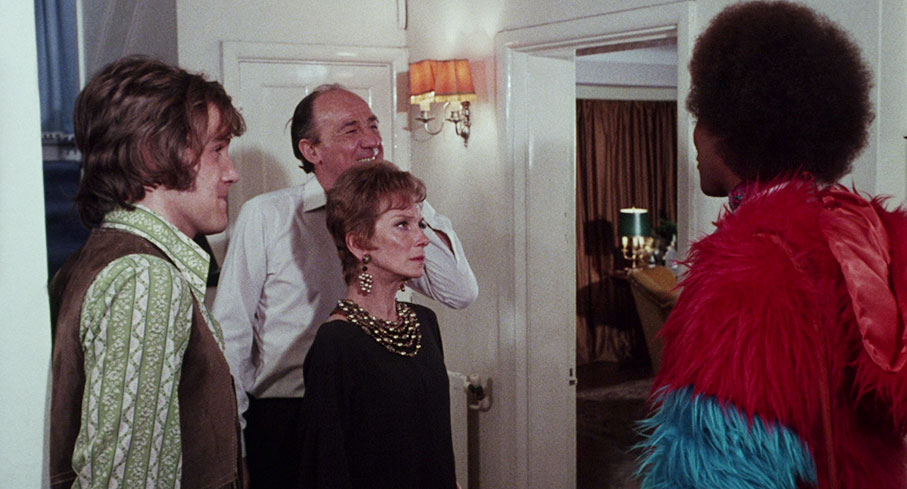
From here on in the film is more concerned with situation than story, being focussed primarily on Lettice's reaction to her son's new girlfriend and her attempts to establish whether Jo really is a woman. George, although intermittently flustered, seems more willing to accept Jo on face value, but is pestered by his wife into assisting with her increasingly desperate investigation. Repeatedly, George is pushed by Lettice to ask a direct question of Jo that Lettice herself seems afraid to pose, and is later corralled into assisting with a search of Jo's luggage for gender-specific underwear, having already been bullied into phoning Jo's parents (too-brief appearances by the excellent Rudolph Walker and Elisabeth Welch) to ask if they have a daughter. The more frantic this investigation becomes, the more the film risks tipping over into farce, reaching a peak when Lettice and George finally attempt to tell Laurie and Jo what's on their minds and they seem to lose the power of coherent speech.
It is, I would suggest, vitally important when viewing Girl Stroke Boy to do so in context of when it was made. Although records of individuals who defined themselves as what we would now regard as transgender go back centuries and include some very prominent figures (the Roman emperor Elagabalus amongst them), the film was released just six years after the term 'transgender' was first coined, and only four years after the UK introduced the Sexual 1967 Offences Bill, which finally decriminalised homosexual acts, though only in private between two men over 21 years of age. Even then, this was only in England and Wales – astonishingly, it was to be another 23 years before the same rights were granted in Scotland. There were dismayingly few positive depictions of homosexual characters in British cinema of period, and as so pertinently pointed out by Alex Davidson in his excellent evaluation in the special features, those that were presented in a sympathetic light tended to be portrayed as tragic or doomed individuals, or over-theatrically camp, while even the inclusion of a black gay character was effectively uncharted territory.
All of which brings us back to the original question of whether Jo is or is not intended to be read as a transgender man or woman. You could argue that by never confirming either way, the film does allow more intolerant viewers of the day to convince themselves that, however unconventional Jo might be, the relationship between her and Laurie is still a heterosexual one. There, let's all breathe a sigh of homophobic relief. In terms of the themes that the film explores, I'm not sure that it matters whether Jo was male or female at birth, though the decision to cast a male actor, one who accurately echoes several character traits of a transgender colleague of my past acquaintance, saw me instantly see Jo as a man who has gender realigned as woman. And this, for the time, was genuinely radical.
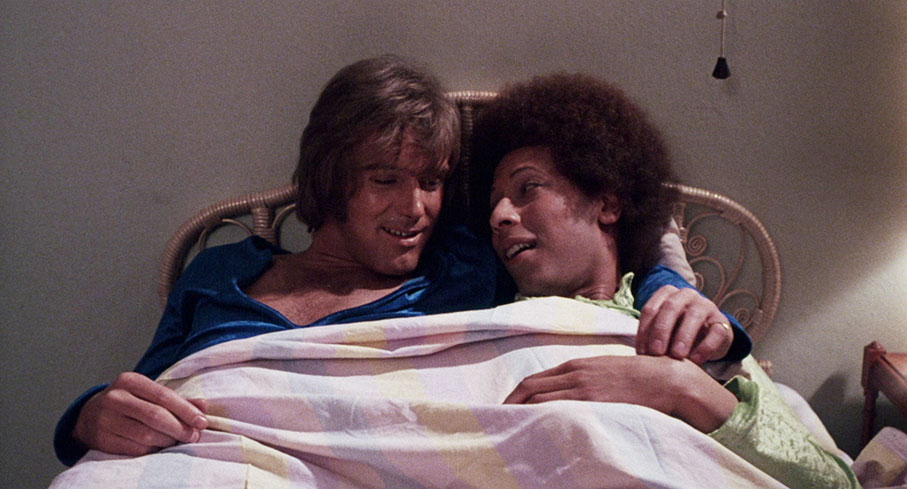
Even more progressive for its day is the film's upbeat presentation of Jo and her relationship with Laurie, which is portrayed as a loving and mutually supportive one. Jo is played by Straker in a realistic manner, with no overly camp behavioural tics, and the self-confidence of someone who has recognised and become fully comfortable with her sexual identity. She and Laurie are convincingly relaxed in each other's company, epitomised by their first night at the house, when Laurie sneaks into Jo's room and climbs into her bed, and the two lie in each other's arms and talk about their love life. So believable are they as a couple that when they have a spat after sneaking downstairs to make love, I was genuinely pained by the prospect that this relationship might then go the way of conservative movie convention. Yet despite Laurie's problematic psychiatric history (another get-out clause for the prudes, one suspects), he and Jo prove to be the voices of reason here, and become the trigger points for film's central themes of tolerance, prejudice, and middle-class hypocrisy. Central to this is the sometimes infuriating Lettice, who despite claiming early on to be open to the idea of an interracial friendship (she dismisses the very notion that it could be anything more serious) is unwilling to entertain the thought that her son could be involved with someone who does not conform to other societal conventions. George, on the other hand, initially appears to be more tolerant, but there is a suspicion that he prefers to bury his true feelings on anything controversial simply to avoid a fuss. It also, for Lettice, seems to be as much about what others might think as whatever prejudices she might hold. This quickly becomes clear when, a couple of minutes after first meeting Jo, Lettice dismisses the very idea that she'd planned a dinner party, and when their fiends Peter and Pamela Hovendon (Peter Bull and Patricia Routledge) show up at the door, she orders George to send them away with wild tales of a sudden sickness. At this point, it's all about keeping up appearances at whatever cost, and the suggestion that she and George have somehow lost their minds (the noise that George makes through the door to scare their friends away should see to that) is preferable to their friends seeing the girl her son has fallen in love with.
There's no doubt that Girl Stroke Boy was an important film for its day, despite being one that rarely gets discussed (it was doubtless overshadowed by the same year's Sunday Bloody Sunday, which tends to take the lion's share of the credit as a ground-breaker in the on-screen portrayal of polymorphous relationships). How it works as a film is a slightly different matter. Although written by Caryl Brahms and producer Ned Sherrin, it was based on a stage play titled Girlfriend by David Percival, and even if you were not aware of this fact, there's a good chance it'll dawn on you long before the halfway mark. The film's stage origins are sometimes clearly evident, in its single primary location, in the sort of smart dialogue that actors love but does not really reflect how people speak, and in the theatricality of some of the line delivery. That said, the performances are definitely one of the principal draws here. As a master of acting befuddled and discomforted by others (check out his glorious portrayal of Professor Parkins in Jonathan Miller's Whistle and I'll Come to You), Michael Hordern is delicious casting as George, and while Joan Greenwood does sometimes run away with Lettice's building paranoia and frustration, it always feels right for her character and provides the film with some of its more outlandishly amusing moments. Clive Francis – who the same year would have a memorable small role as the lodger in Stanley Kubrick's A Clockwork Orange – convinces completely as Laurie, particularly in how relaxed he is in Jo's company, with his affection for her never coming across as 'acted', if that makes sense. But for me, the most captivating performance comes from Peter Straker as Jo. He reveals in the on-disc interview (see below) that he was encouraged by director Bob Kellet to play it straight (no gender pun intended) and avoid the more clichéd flourishes that make so many gay characters in films of the period feel so awkward today. This results in a character I believed in from the moment she first speaks, and one whose fate I thus became quickly invested in. Jo frequently comes across as the smartest and most level-headed one in the room, which the film uses to further highlight the absurdity and cruelty of societal prejudices in whatever ridiculous form they may take.
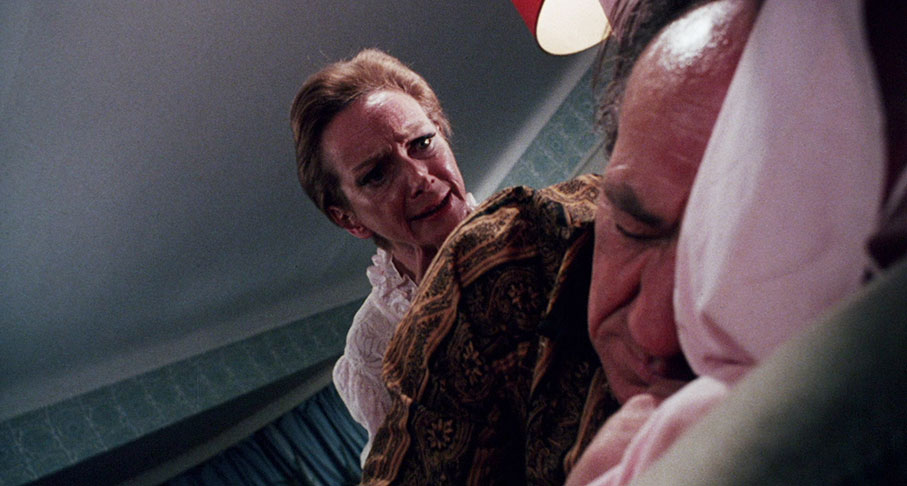
Director Bob Kellett, who specialised in bringing TV comedy series to the big screen (Up Pompeii, The Alf Garnett Saga, Are You Being Served?) works wonders with the performers but seems on slightly less certain ground with some of his camera placement and editing decisions, as naturalistic coverage suddenly gives way to huge facial close-ups and stylised angles. The use of sometimes long takes gives his actors room to breathe, but there is a sometimes loose continuity of cinematic style, creating the sense that Kellett was winging it on set and just trying out ideas to see what landed, quite possibly the result of an insanely short two-week shooting schedule in what looks to be a location rather than a studio set. For some, this will not matter or perhaps not even register, but I did find these style switches a little distracting at times, as it kept reminding me that I was watching a film, and coupled with the more theatrical elements outlined above, that I was watching a film of a stage play.
If you can live with this or not see it as an issue or even disagree with me completely on this score, Girl Stroke Boy is still an important and intriguing work in the development of LGBTQ cinema, and for my money Peter Straker's performance Jo remains one of the most honest and sympathetic representations of a transgender character in late twentieth century British cinema. The four leads are terrific, the too-briefly seen supporting cast is peppered with famous faces, and the film's heartfelt but intelligent and unsentimental plea for tolerance in an intolerant world has lost none of its relevance in the fifty years since its original release.
Framed in its original aspect ratio of 1.85:1, this restoration by Powerhouse Films at Final Frame Post in London was scanned at 4K from a rare positive element after the original 35mm camera negative could not be located, with restoration work undertaken at 2K to remove dirt and unstable frames. This is not a film you would use to show off your sparkling new AV system, with whole scenes lit in a rather flat and naturalistic style, and the Mason home set-dressed in a deliberately humdrum manner. Yet the image is still in most impressive shape, with clearly defined detail, a generally well-balanced contrast range, and a nicely handled colour palette that captures the dourly earthy décor of the Mason home but really springs to life when the colourful clothing worn by Laurie and Jo is on screen. As the restoration details above suggest, the image is clean of dust, dirt and damage and always stable in frame, with a fine film grain visible throughout.
The Linear PCM 1.0 mono soundtrack was mastered from the original 35mm optical soundtrack element and does its job without distracting background hiss or fluff. The dialogue is always clear and free of distortion, and in a film when the talk is almost continuous, that'll do nicely.
Optional English subtitles for the deaf and hearing impaired available should you need them.
Peter Straker: As Simple as That (13:39)
A most welcome new interview with actor Peter Straker, who recalls auditioning for the role by having to kiss another man whilst being closely watched by others, but was happy to take a role that would mean being in a feature film, and even happier when he knew he would be working with Michael Hordern and Joan Greenwood. He outlines his approach to playing Jo at the dawn of a period of breaking down stereotypes, speaks highly of director Bob Kellett and hair stylist Ramon Gow, and notes how the clothing choices helped to give his character an androgynous feel. He also has a funny story about Joan Greenwood, and admits that he hates watching himself on screen.
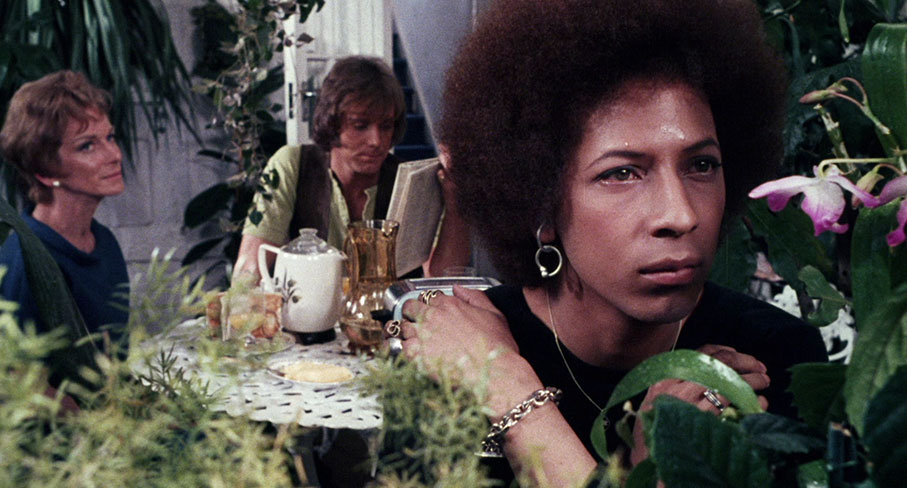
The BEHP Interview with John Scott (98:35)
A feature-length interview with composer John Scott, conducted by Alex Gleason and Martin Sheffield on 12 July 2018 for the British Entertainment History Project. The generous running time allows for a detailed examination of Scott's fascinating and varied career, which began with him joining the army to learn music and led to session musician work and eventually composing music for films. He recalls the "horrible, horrible" music had had to play for famed band leader Nat Temple, working with The Beatles and admiring their innovations with multitrack recording, writing scores for with Norman Warren, Harry Alan Towers and Jacques Cousteau, how a grudge-bearing Bernard Herrmann tried to poison people against him, and so much more. Individual films are covered in interesting detail, including the creation of electronic animal sounds on early synths for The People That Time Forget (1977), the ecological documentary Time Bomb at Fifty Fathoms (1978), which representatives of polluting industries managed to get banned in the UK, and how he ultimately couldn't win whatever he did on Greystoke: The Legend of Tarzan, Lord of the Apes (1984). He also opines that you haven't arrived until you've had a score rejected, and reveals that Jerry Goldsmith was one of his gods. With such a large CV and such a long career, it's inevitable that not all of his film work gets coverage here, and unfortunately Girl Stroke Boy proves to be one of the causalities, but this is still enthralling stuff and essential viewing for anyone with an interest in film music.
Alex Davidson: Ahead of its Time (16:17)
Film historian and curator Alex Davidson delivers an excellent evaluation of the impact and continuing relevance of Girl Stroke Boy, exploring its themes, its central characters, the performances, and how Jo is treated by the film as a fully-rounded individual and not an object to be analysed by the straight characters. He contextualises the film in its place and time, compares it with other cinematic depictions of queer characters in the 1960s and early 70s, and notes the similarities to Guess Who's Coming to Dinner, in the process outlining why he believes Girl Stroke Boy is the superior film. I got a lot from this.
Image Gallery
20 screens of crisp monochrome production stills, lobby cards, press note pages and posters. Perhaps the most intriguing poster has emblazoned in large letters across the top, "FOR A GAY NIGHT OUT SEE Girl Stroke Boy" and teams the film with School for Virgins.
A Couple of Beauties (29:00)
A paper-thin plot involving a barman fleeing town after witnessing a gangland shooting and hiding out by working as a drag artist in full public view is effectively just background fluff in a film created to showcase Manchester-based female impersonator, Bunny Lewis. The sort of supporting short that I used to groan my way through in my youth whilst waiting for the feature I paid to see to start, this 1971 work is loaded with cheesy innuendo, a style of oh-so British nudge-nudge comedy I was never a fan of and have not really warmed to since, though I couldn't fight those annoying pangs of nostalgia that watching this inevitably awakened. Famous faces from the period abound, and the film's line in humour can be summed up in the sequence in which Bunny has to share a bed with an attractive young woman who is unaware of her bed-mate's true identity. "Mind if I snuggle up close?" the girl asks Bunny. "I always like something to hold on to. I say, you are a big girl, aren't you?" as striptease music plays in the background and Bunny responds with a sleazily delighted, "Cor!" This also has optional English subtitles for the hearing impaired.
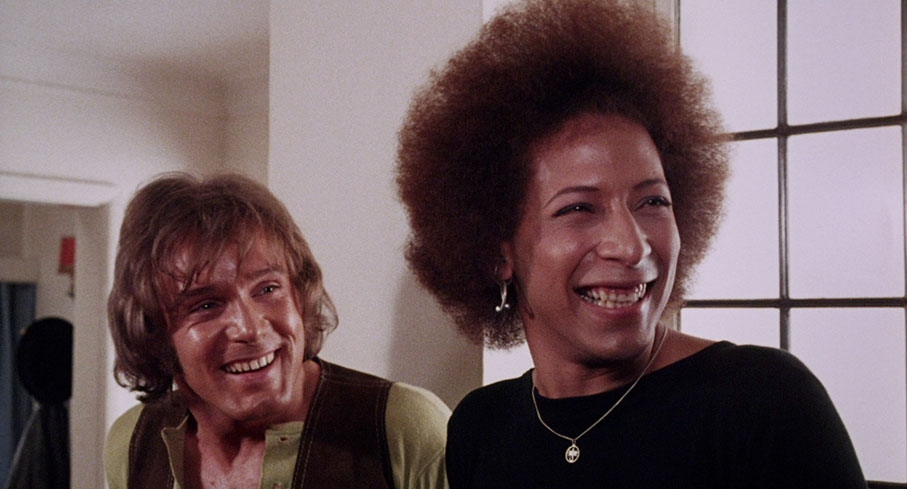
Booklet
The credits for the film are followed by a fascinating essay by filmmaker, journalist and author Jane Giles, which includes information on the source play, a detailed assessment of the film's characters and themes, and some clips from a few of the more unpleasantly prejudiced critical reviews of the day. One of my favourite lines has Giles describe the film thus: "Draped in tonal strangeness and innuendo, Girl Stroke Boy feels like a fairy tale as presented by Monty Python." That line alone would make me want to see it. Next is a reproduction of a 1972 interview with Peter Straker by Peter Holmes and Denis Lemon for Gay News, in which Straker is more critical of the film's problems than in the more recent on-disc interview, and talks about his dual careers as an actor and a singer. Extracts from three reviews of the original stage show, Girlfriend by David Percival, are followed by two less-than celebratory reviews of the film. Credits for A Couple of Beauties are joined by a short essay on it, and there's even an examination of the poster and why changes to the artwork were imposed.
Not everything about Girl Stroke Boy works well for me, as while I enjoyed the performances and deeply admire the film for its positive and level-headed presentation of a transgender character at a time when most people had never even heard the term, the sometimes stage-bound feel, occasional drifts towards conversational chaos and visual style switches do give it a sometimes artificial feel. But much of it nonetheless impresses, and its digs at prejudicial attitudes to marginalised groups and those who do not conform to societal norms is as unfortunately relevant now as it was back in 1971. It's a rarely discussed work that's absolutely worth seeing and that I have a feeling will grow on me further with subsequent viewings, and Indicator has done a typically fine job with this Blu-ray – there's no commentary track, but the restoration and transfer are first-rate, and the supplied special features are of a very high order. It has to come recommended.
|